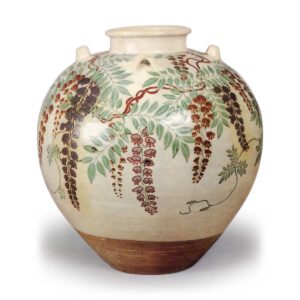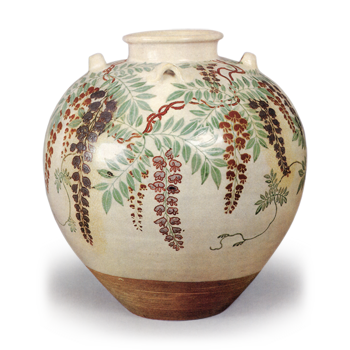
National Treasure
Height 28.8cm, Bore 10.1cm, Bottom 10.5cm
MOA Art Museum
This tea jar is the most famous of the numerous posthumous works left behind by Omuroyaki Ninsei, who perfected the art of Kyoyaki pottery in overglaze enamels.
The production of leaf tea pots in Japan began in the Bizen and Seto kilns, where they were imitated from the Chinese tea pots that had been highly prized since the mid-Muromachi period (1392-1573), and later in the Shigaraki, Iga, and Karatsu kilns. The tea pots produced by Ninsei in the Edo period were completely different from those of the past, with their richly decorative and elegant color painting, and a new sensibility that broke down previous concepts of tea pots. It can also be said that these tea pots were a symbolic work of craftsmanship that represented the Kyoto-style culture of the early Edo period.
The main characteristic of Omuroyaki Ninsei’s style was his skill on the potter’s wheel, and this tea jar alone shows just how outstanding his technique was. From the base of the body to the mouth, the potter’s wheel is evenly ground to a thinness rarely seen in large pots, giving it a truly elegant appearance. The unique white glaze with fine penetrations from the mouth to the hem of the body is applied, and the glazed surface is soft and gives a sense of warmth that is unique to ceramics and not found in porcelain.
The composition is skillfully composed with clusters of wisteria flowers in full bloom hanging down from the shoulder to the body, with leaves and vines in between. The color scheme of the flowers is varied, with red bordered by silver, light purple bordered by red, and red bordered by gold, and the many leaves in light green are painstakingly veined in the center of each leaf. However, it is possible that Ninsei did not consider that some of the silver color would later oxidize and blur around the leaves.
The bottom of the jar is covered in clay, and the left side of the flat bottom is stamped with the “Insei” seal, commonly known as a large seal. It was later owned by the Nagao Museum of Art, and after World War II, it was transferred to the World Salvation Church, and is now in the collection of the MOA Museum of Art.



